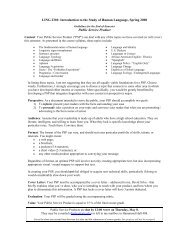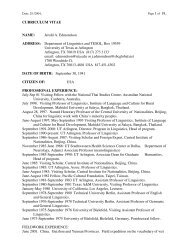1 A phonetic study of the Sui consonants and tones Jerold A ...
1 A phonetic study of the Sui consonants and tones Jerold A ...
1 A phonetic study of the Sui consonants and tones Jerold A ...
You also want an ePaper? Increase the reach of your titles
YUMPU automatically turns print PDFs into web optimized ePapers that Google loves.
true vocal folds, <strong>the</strong> ventricular folds, <strong>and</strong> <strong>the</strong> arytenoid cartilages are all abducted but not to <strong>the</strong><br />
extent <strong>of</strong> forced inhalation. The brea<strong>the</strong>d state <strong>of</strong> <strong>the</strong> glottis is characterized by a slightly<br />
turbulent airflow through <strong>the</strong> wide open glottis. The degree <strong>of</strong> stress <strong>and</strong> aspiration can influence<br />
<strong>the</strong> width <strong>of</strong> <strong>the</strong> opening <strong>of</strong> <strong>the</strong> glottis <strong>and</strong> <strong>the</strong> width <strong>of</strong> <strong>the</strong> opening <strong>of</strong> arytenoid cartilages. The<br />
heavier <strong>the</strong> aspiration <strong>and</strong> <strong>the</strong> higher <strong>the</strong> stress, <strong>the</strong> wider open <strong>the</strong>y are <strong>and</strong> <strong>the</strong> longer <strong>the</strong> VOT<br />
lag.<br />
The syllable final voiceless oral stops /-p -t -k/ represent final voiceless unreleased<br />
double articulations <strong>of</strong> glottal stop plus oral stop simultaneously [��p ��t ��k]. 4 The final voiceless<br />
unreleased double articulations [��p ��t ��k] <strong>and</strong> <strong>the</strong> glottal stop [�], including <strong>the</strong> glottal stops<br />
preceding preglottalized <strong>consonants</strong> [�b �d (��) �j �w �� �m �n �� ��] all have a closed<br />
UNPHONATED state <strong>of</strong> <strong>the</strong> glottis (Catford 1990: 26). We now have direct visual evidence that <strong>the</strong><br />
preglottalized <strong>consonants</strong> are preceded by moderate glottal stops, which will be discussed below.<br />
The voiced <strong>consonants</strong> following <strong>the</strong> initial glottal stops are normally in modal voice. We have<br />
never recorded instances <strong>of</strong> preglottalized <strong>consonants</strong> following glottal stop in creaky voice.<br />
In <strong>the</strong> literature, glottal stop is usually defined simply as a closed or tightly closed glottis,<br />
which are nei<strong>the</strong>r precise nor complete definitions <strong>of</strong> glottal stop. The production <strong>of</strong> glottal stops<br />
includes complete adducted vocal folds, partially adducted ventricular folds helping to reinforce<br />
<strong>the</strong> glottal closure, <strong>and</strong> slight constriction <strong>of</strong> <strong>the</strong> whole laryngeal vestibule. The laryngeal<br />
vestibule, according to Zemlin (1988), is defined as <strong>the</strong> supraglottal cavity that extends from <strong>the</strong><br />
ventricular folds upward through <strong>the</strong> aditus laryngis. It is formed anteriorly by <strong>the</strong> epiglottis,<br />
posteriorly by <strong>the</strong> apexes <strong>of</strong> <strong>the</strong> arytenoid cartilages, <strong>and</strong> laterally by <strong>the</strong> aryepiglottic folds. The<br />
sphincter mechanism constriction <strong>of</strong> <strong>the</strong> supraglottal cavity is on a continuum beginning with a<br />
moderate glottal stop described above <strong>and</strong> can increase until <strong>the</strong> aryepiglottic sphincter<br />
mechanism can form a complete closure as in <strong>the</strong> production <strong>of</strong> an epiglottal stop. Although <strong>the</strong><br />
sphinctering mechanism <strong>of</strong> a moderate glottal stop is slight when compared to an epiglottal stop,<br />
it should not be ignored. It is part <strong>of</strong> <strong>the</strong> basic production components <strong>of</strong> a glottal stop in Tai <strong>and</strong><br />
Kam-<strong>Sui</strong> languages.<br />
4. Tone plots. The tone plots presented here are based on data taken from one <strong>of</strong> <strong>the</strong><br />
authors, James Wei, a native speaker <strong>of</strong> <strong>Sui</strong> from <strong>the</strong> village <strong>of</strong> Miaocao about seven km from<br />
Shuilong, one <strong>of</strong> <strong>the</strong> locations in SDB 1956. Mr. Wei produced multiple tokens <strong>of</strong> actual <strong>Sui</strong><br />
vocabulary items as indicated below. The recordings were made in Beijing, China at <strong>the</strong> Central<br />
University <strong>of</strong> Nationalities with high quality audiotape using a Sony TCM-5000 pr<strong>of</strong>essional<br />
quality cassette tape recorder <strong>and</strong> a ATR 20a Audio Technica dynamic, uni-directional<br />
microphone. Each test item was repeated three or more times <strong>and</strong> from <strong>the</strong>se multiple tokens <strong>the</strong><br />
pitch trajectories were extracted using WinCecil Speech Analysis s<strong>of</strong>tware (SIL International).<br />
In order to eliminated artifactual differences from <strong>the</strong> multiple repetitions <strong>of</strong> a given lexical item,<br />
each set <strong>of</strong> pitch trajectories was normed for length <strong>and</strong> for pitch height <strong>and</strong> <strong>the</strong>n a mean value<br />
4 Calling <strong>the</strong>se sounds double articulations means that we are following <strong>the</strong> rank order <strong>of</strong><br />
strictures <strong>of</strong> J. C. Catford 1977. If we choose to follow K. L. Pike 1943, <strong>the</strong>se sounds would be<br />
described as glottalized stops, since Pike treated all glottal stops as a lower rank order <strong>of</strong> stricture than<br />
oral stops.<br />
7





